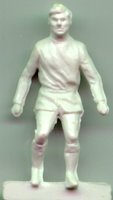
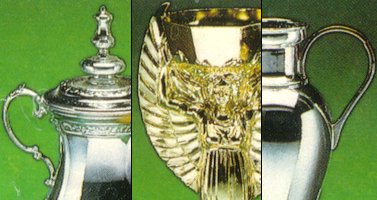
| Peter Upton's |
|
Subbuteo Tribute Website. |
|
Charles Stadden and the Lost Range. |
Charles Stadden was definitely a man of many talents. He is probably most famous for his military models. The book "Model Soldiers in Colour" by Roy Dilley and Philip Stearns explains how after the second world war model soldier production started to diversify. As well as toy soldiers and those designed for war games, high quality models began to be produced for collectors. To quote the book - "It is generally accepted that the artist more responsible than any other for establishing the high-quality collector figure was Charles Stadden, who commenced his production in 1951.... He brought his superb craftsmanship to the creation of an enormous range of subjects, the majority in 'standard' 54mm scale. Over the years the Stadden range has become renowned for the accuracy and vivacity of its component figures, and the master craftsman has worked in other scales... with equal facility."
In addition to this, Charles Stadden was also an accomplished artist in oils and watercolour, where his interest in military subjects was also to the fore. He also wrote books on military history.
This would be enough for most people, but luckily for us Subbuteo fans in the 1960s and 1970s Mr Stadden was also a patternmaker for various British toy manufacturers. These included Triang, Corgi, Hornby, Scalextrix (where he designed the head and shoulders of the drivers) and (yes, you've guessed it) Subbuteo. The patternmaker is the original sculptor of the figures. The Subbuteo patterns were carved and engraved in white metal, usually at the actual size of the final figures (although some may have been produced at twice the size).
Steel moulds are then produced from the original sculpture. These have a very long life, as witnessed by the constant re-releases of Airfix models. So hopefully the moulds for all our favourite Subbuteo things are still kicking about somewhere.


For most Subbuteo fans the key Charles Stadden design is the classic heavyweight football figure (this is just the footballer of course, and not the base). I'm sure this item was crucial to the popularity of Subbuteo in the 1970s. The magnified scan of an unpainted figure vividly shows the level of detail in this sculpture.
Charles Stadden was also responsible for the early trophies - the Jules Rimet World Cup, the FA Cup, and original European Cup, all of which are beautifully crafted. His original Jules Rimet was carved in tin alloy, with a carved wooden plinth.
For those of you wondering why Subbuteo did not produce the new style FIFA World Cup for the 1974 competition, it may well have been due to Mr Stadden turning this down because he disliked the design.
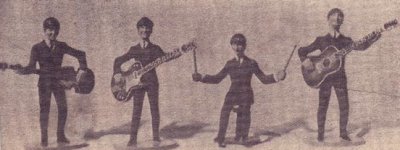
This picture (from a local paper of the time) shows another Stadden designed set, The Beatles. The article explains that these figures were modeled from magazine photographs and had been approved by the Beatles themselves. They apparently took eight days to make, and were produced in Mr Stadden's garage. Interestingly, the article then tells us that he had orders for more pop stars, and next in line were Cilla Black, Gerry Marsden, Dave Clark, Billy J Kramer, and Freddie and the Dreamers. I'm not sure what happened to these figures, but Mr Stadden did receive payment for Cilla Black, her microphone, Dave Clark, Freddie of the Dreamers, and Gerry of the Pacemakers. So the original pieces were produced. This does explain why the Subbuteo advert for the Beatles set stated "number one in the series".
Subbuteo items invoiced by Charles Stadden in the 1960s include -
C103 Invoiced 10 September 1962. Footballer in tracksuit running.
C104 Invoiced 10 September 1962. Trainer in sweater and cap. Manager in trilby and suit. Press Photographer standing. Press photographer kneeling.
C107 Invoiced 06 June 1963. Referee. Linesman with Flag.
Other items known to be produced by Charles Stadden are the Targetman figures, the cricketers, the supporters, and he also made masters for the rugby set.
Charles Stadden sadly passed away in September 2002 at the age of 83. His son Andy has been going through his business papers, and has kindly provided the following information, which gives us a fascinating insight into some Subbuteo items that never were - a "lost" range from the golden age of the late 1970s.
The Lost Range.
In the late 1970s, Subbuteo Sports Games (SSG) were looking to increase and update their figure range. In a letter from February 1979, SSG director JT Burbidge thanks Mr Stadden for the "drawings of last year's models" which, "enabled everyone here to visualize what I had in mind".
Luckily, Mr Stadden's fantastic watercolour drawing was still enclosed with the letter. This enables us to see the original illustrations for three sets that were to become the mainstay of the Subbuteo accessory range for nearly twenty years....
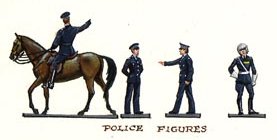
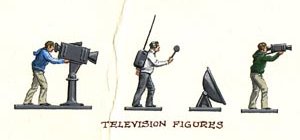
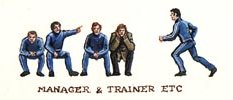
...but the watercolour also includes two other sets that you probably won't have seen before. These are extra sets of spectators, which for reasons unknown never made it into production.
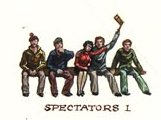
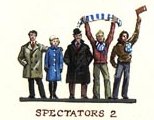
Mr Burbidge then produces a list of further models that he would like to see drawings of "as soon as possible" for the next year of production. Sadly, this range never saw the light of day, but it is listed here for your enjoyment (with Mr Burbidge's notes and illustrations where appropriate) :-



How much fun does that all sound? JT Burbidge might not have been the artist Charles Stadden was, but his illustrations do have a good Subbuteo feel, and one can only imagine the further heights to which Mr. Stadden may have taken his ideas.
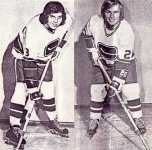

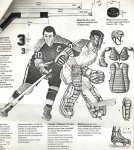
In addition to his drawings, Mr Burbidge enclosed some pictures of ice hockey players for reference. You can see the stance of these figures mirrored in the field hockey set of 1981, and it would be fair to assume that game replaced the ice hockey idea. Perhaps it was cheaper to produce ordinary hockey, perhaps the puck was proving problematical, or perhaps they just felt that the female market for Subbuteo products was completely untapped.
So the only figure to appear from this list, seems to be the kneeling ambulance man, which appeared in the first aid set of 1981 (sadly without the wheeled stretcher).
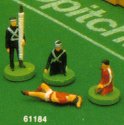
That concludes this page on Charles Stadden's Subbuteo output, but if anything else comes to light, I will post it here.
If you are interested in knowing more about Charles Stadden, or pattermaking in general, then please visit Andrew Stadden's website.....
[ Main Page ]